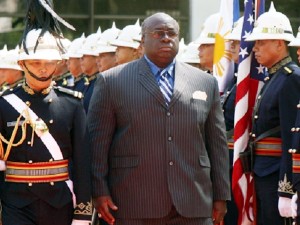MANILA, Philippines – United States Ambassador to the Philippines Harry Thomas Jr. on Wednesday said that amid countries’ territorial disputes over areas in the West Philippine Sea (South China Sea), the US would remain firm to its commitment under its Mutual Defense Treaty (MDT) ties with the Philippines, and its plan to reposition its military forces in the Asia Pacific region.
“Rising tensions is in no one’s interest but, as Secretary Hillary Clinton has stated, we are a Pacific nation, the United States, we stand by our Mutual Defense Treaty,” Thomas said.
Speaking at the at a Makati Business Club’s (MBC) general membership meeting on the topic The Significance of the Philippines – United States Alliance in a Volatile Pacific Region, Thomas said: “We have made a re-balance or re-pivot to ASIA on all sides and that will continue.”
Thomas, in his speech and in interviews with reporters at the sidelines of the meet, reiterated the United States’ position of having peaceful resolutions to the disputes in accordance with international law.
He added that the West Philippine Sea issue was something that the US worked out on a daily business with concerned Philippine government officials, but that they called on all nation states to “sit and decide on things at the negotiating table.”
“We don’t want to further escalate tensions; we want peaceful resolution of tensions but we want all countries to live up to their agreements and that is why we support the Code of Conduct between China and Asean (Association of Southeast Asian Nations). We think this is a better way to resolve this,” Thomas said.
Tensions in the West Philippine Sea, internationally known as South China Sea, have been rising in the recent months, with countries’ contesting their claims over the area, and China deploying its ships around the Scarborough Shoal.
Apart from China, the Philippines, Brunei Malaysia and Vietnam, and Taiwan claim parts of the sea.
Manila has been pushing for diplomatic, legal and political solution to the dispute, which began when maritime authorities caught Chinese fishermen reportedly poaching in the disputed waters.
China claims sovereignty over nearly all of the West Philippine Sea, which is believed to sit atop vast amounts of oil and gas, is one of the region’s most important fishing grounds, and is home to shipping lanes that are vital to global trade.
Asked about the specifics of the US plan to rebuild its forces in Asia in relation to assistance to the Philippines, Thomas said that they were looking for a “balance” in the relationship, not only focusing on military plans but also beefing up efforts for humanitarian assistance, disaster mitigation efforts and economic investment.
He, however, said that in terms of equipment, they we’re bringing the second cutter, the Dallas, to the Philippines, in about six to eight months. He said that Filipino sailors were already training on manning the ship.
Thomas also said that he would be heading to Puerto Princesa, Palawan Thursday to donate the last of the six ships the US had been providing to the Philippine National Police (PNP) to help the agency capture smugglers.
He said that the White House would also be sending a team to the country next week to meet Filipino officials and engage sectors in efforts to combat human trafficking.
He said he was also pleased that members of other Asean were also stepping up to assist the Philippines militarily across a broad range especially in disaster and humanitarian assistance.
“We have poured last year $4 million to help cities train to prevent and mitigate flood. We’ll put more money in next year for disaster relief because clearly climate change has already been the ring of fire. We have US AID and the defense department working on Philippine organizations on recommendations on these assistance,” he said.
He also noted how the US had more peace corps volunteers in the Philippines than any country in the world, and that there were over 200 peace corps volunteers in the country.
Thomas stressed how the Philippines should particularly work on its economic investments and initiatives and step up to not lag behind other ASEAN nations, saying that of the $150 billion investment in ASEAN, $100 billion was in Singapore.
“How do you attract that $100 billion that Singapore has to the Philippines that is not up to us, that is up to you to design,” Thomas said.
He noted how the Philippines ranked eight or ninth economically among ASEAN countries but that he believed that the Philippines could be number one.
Thomas said that they were working on getting American businessmen to look favorably on Southeast Asian nations, but that Southeast Asian nations-based business should open up and be more transparent economic societies.
Thomas said that with his experience in the Philippines, he believed that the country needed to work on transparency in court system and bureaucracy, speed of decision making, and predictability.
